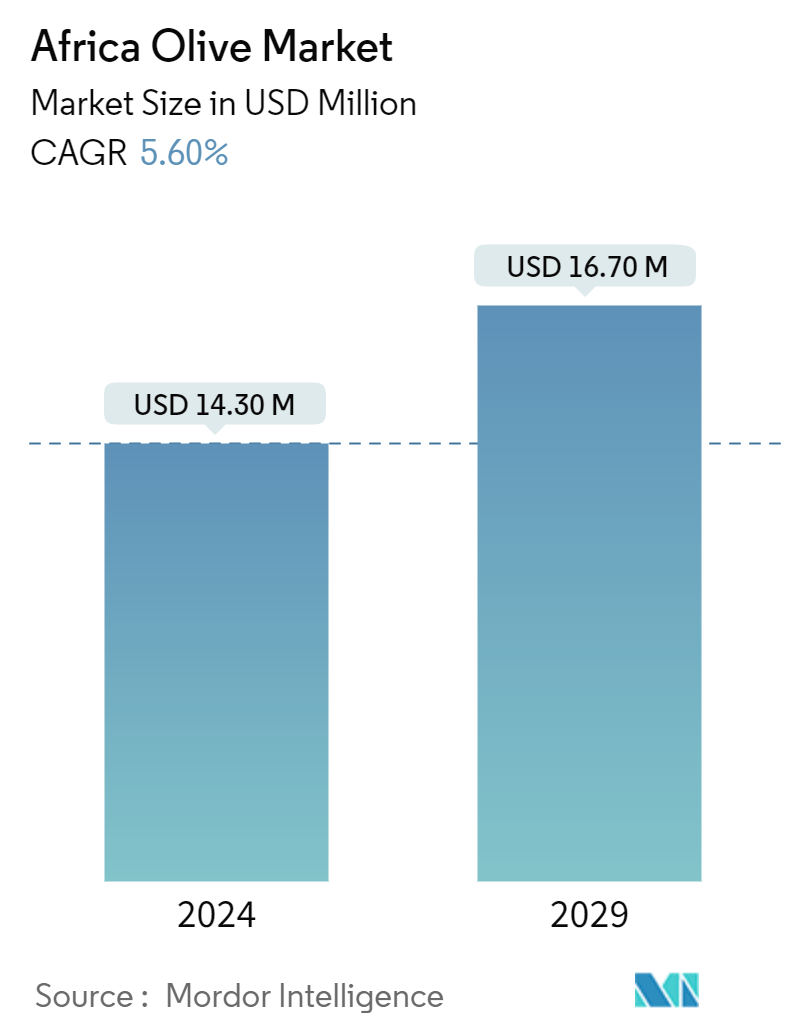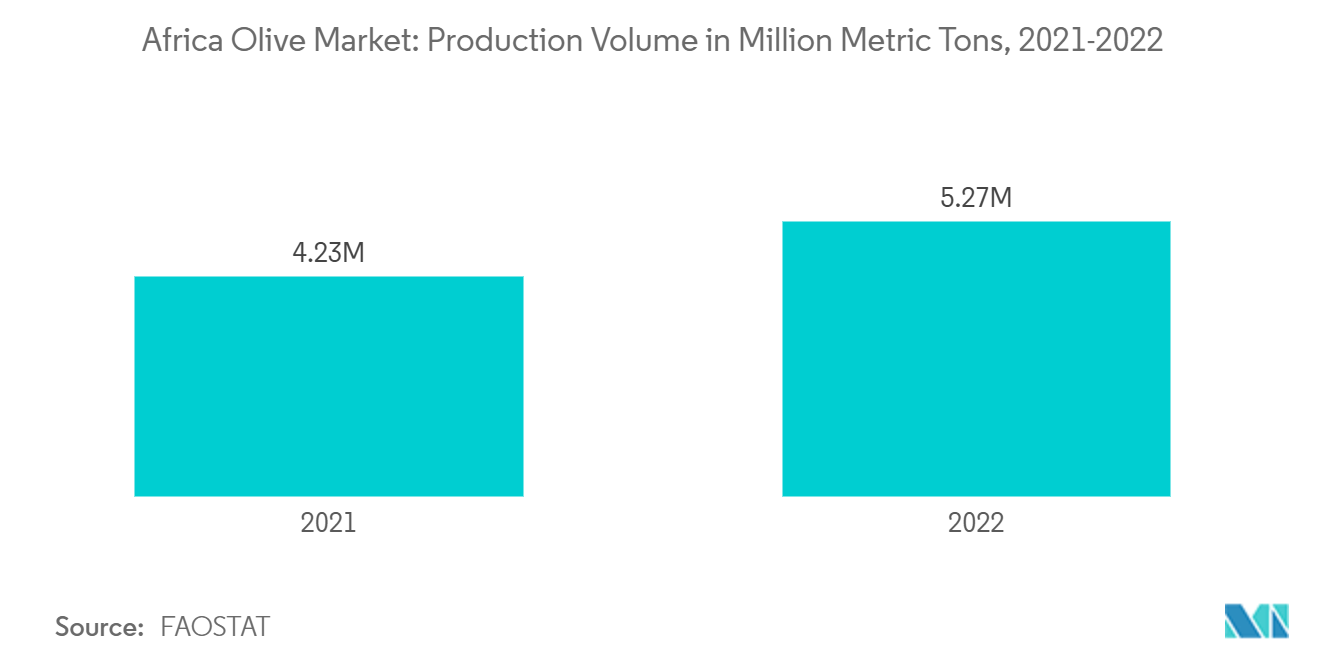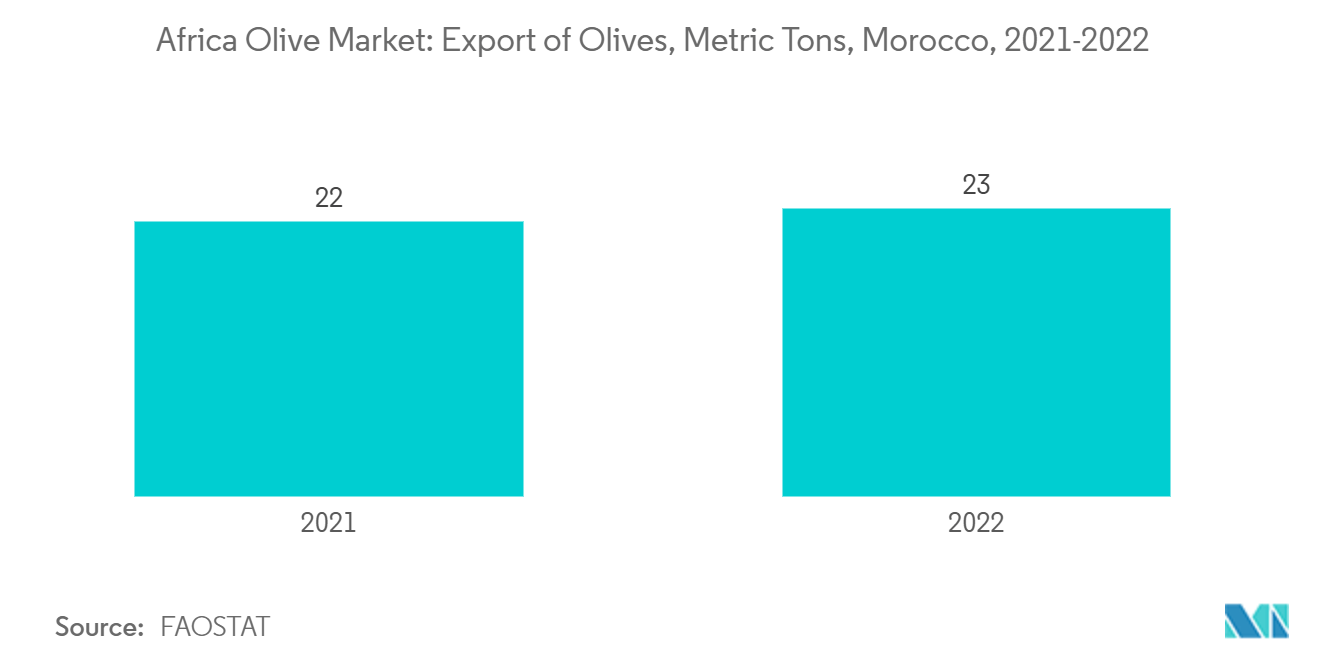Africa Olive Market Size

| Study Period | 2019 - 2029 |
| Base Year For Estimation | 2023 |
| Forecast Data Period | 2024 - 2029 |
| Market Size (2024) | USD 14.30 Million |
| Market Size (2029) | USD 16.70 Million |
| CAGR (2024 - 2029) | 5.60 % |
Africa Olive Market Analysis
The Africa Olive Market size is estimated at USD 14.30 million in 2024, and is expected to reach USD 16.70 million by 2029, at a CAGR of 5.60% during the forecast period (2024-2029).
- The African olive market is witnessing steady growth, fueled by rising demand in both the food service and retail sectors. This surge is further bolstered by an increasing appetite for table olives, heightened olive production, and a notable shift in consumption patterns, with olive oil becoming a staple in many diets. The health benefits associated with olives have notably heightened their appeal across African nations. Numerous studies highlight that olives are nutrient-rich, potentially aiding in cancer prevention and alleviating nerve-related issues. Their beneficial fatty acids, antioxidants, and vitamins have catapulted olive oil to prominence as a sought-after healthy fruit oil in the region.
- Moreover, the olive market's robust expansion is largely attributed to the surging demand in food service and retail avenues. In various African nations, olives play a pivotal role in the culinary landscape, being integral to dishes like sandwiches, pizzas, pasta, and salads, all of which are staples in restaurants and food outlets. This culinary trend, combined with a booming food and beverage (F&B) industry, underscores a primary driver of the market's growth.
- Morocco leads the region in olive production, with more than four million olive trees. For instance, according to FAOSTAT, the production of olives in Morocco was 1,590,504 metric tons in 2021, which increased by 1,968,110.94 metric tons by 2022. The nation's favorable climate, coupled with proactive government initiatives, has catapulted Morocco to the ranks of top global olive oil exporters, especially renowned for its premium extra virgin olive oil. Tunisia, Algeria, and Egypt also emerge as significant players in olive production.
- The government has prioritized improving irrigation, and increasing market productivity since olive has the potential for much more growth, especially in terms of higher value-added organic olive oil. Some factors driving the olives market are the rise in the demand for olive oil, dietary benefits, and pharmaceutical uses, which will boost the market's growth during the forecast period.
Africa Olive Market Trends
Rising Demand for Olive Oil Boosts Production in Africa
As demand for olive oil surges, Africa is ramping up its olive production. This uptick can be attributed to heightened health awareness, evolving dietary preferences, and challenges faced by traditional olive oil powerhouses like Spain and Italy, grappling with climate change and drought. These challenges have paved the way for African nations to bolster their olive output. For instance, according to FAOSTAT, Africa's olive production jumped from 4.23 million metric tons in 2021 to 5.27 million metric tons in 2022.
Extra virgin olive oil, celebrated for its heart-healthy monounsaturated fats, has garnered attention for its health benefits. Studies highlight its ability to combat inflammation, reduce LDL cholesterol, and enhance heart health. The Mediterranean diet, which prominently features olive oil, has further fueled its popularity. As consumers become more informed about olive oil's potential in mitigating chronic diseases—ranging from heart ailments to certain cancers—the demand continues to swell. Moreover, the Mediterranean diet's endorsement for longevity and well-being, amplified by media, nutritionists, and health experts, has solidified olive oil's esteemed status.
There's been a pronounced shift towards natural, organic, and unprocessed foods in recent years. Extra virgin olive oil, with its minimal processing, resonates with health-conscious consumers, especially in developed nations are willing to invest in organic and wholesome food. Additionally, as plant-based diets gain traction and the consumption of animal fats declines, olive oil emerges as the favored plant-based fat. Those distancing from butter and animal-derived oils are increasingly embracing olive oil for its health and ethical advantages.

Morocco Dominate the Market in the Region
Morocco stands out as the dominant force in Africa's olive market and plays a pivotal role on the global stage. The Mediterranean climate, especially in regions such as Meknes, Fez, and Marrakesh, provides ideal conditions for olive cultivation. With mild winters and hot, dry summers, Morocco offers the perfect environment for olives to thrive.
In 2022, the Moroccan government, a staunch advocate for the olive industry, launched initiatives like the "Green Morocco Plan." The Ministry of Agriculture reported a 21% increase in olive production in 2022, attributing it to favorable climatic conditions, including 309 millimeters of rainfall, and a rise in olive oil plantations aligned with the Green Generation plan for 2020-2030. Olive oil exports reached a notable USD 41 million, marking an increase from the previous year. The plan's key components encompass expanding olive-growing areas, enhancing irrigation systems, and providing robust support to farmers. Recently, Morocco has made significant investments in its olive orchards, with land dedicated to olive cultivation surging to an estimated 1.2 million hectares. This expansion, combined with modern farming techniques, has significantly bolstered the nation's olive yields.
Consistently ranking among the top five global olive producers, Morocco produces around 200,000 to 300,000 tons annually. A substantial portion of this is exported to key markets in Europe, North America, and the Middle East, especially as European producers face droughts and declining yields. Morocco also exports table olives, which are popular in many regions. For instance, according to FAOSTAT, a rise in olive exports from Morocco was witnessed, jumping from 22 metric tons in 2021 to 23 metric tons in 2023.

Africa Olive Market News
- May 2023: The Moroccan government allocated 16.9 billion dirhams (€1.54 billion) to the Moroccan Interprofessional Olive Federation for irrigation investments. Officials report that while 37.5 percent of the nation's olive groves, covering 450,000 hectares, are irrigated, these groves contribute to 50 to 60 percent of the country's total olive production.
- January 2022: The European Bank for Reconstruction and Development (EBRD) confirmed a new USD 6.2 million loan to the Campagnie General des Industries Alimentaires(COGIA), one of the country's major food manufacturers, to help strengthen the olive farming sector in Tunisia. These funds will be used to develop irrigation projects and foster production, bottling, and exports.
Africa Olives Market Report - Table of Contents
1. INTRODUCTION
1.1 Study Assumptions and Market Definition
1.2 Scope of the Study
2. RESEARCH METHODOLOGY
3. EXECUTIVE SUMMARY
4. MARKET DYNAMICS
4.1 Market Overview
4.2 Market Drivers
4.2.1 Dietary Revolution Leading to An Upsurge in Demand for Olive Oil
4.2.2 Favorable Government Policies and Association Initiatives Promoting Olive Cultivation
4.2.3 Rise in Demand for Naturally Processed Table Olives
4.3 Market Restraints
4.3.1 Extreme Climatic Anomalies Disrupting the Production of Olives
4.3.2 Volatility Of International Olive Oil Prices
4.4 Value Chain Analysis
5. MARKET SEGMENTATION
5.1 Geography
5.1.1 Morocco
5.1.1.1 Production Analysis
5.1.1.2 Consumption Analysis and Market Value
5.1.1.3 Import Market Analysis (Volume and Value)
5.1.1.4 Export Market Analysis (Volume and Value)
5.1.1.5 Price Trend Analysis
5.1.2 Algeria
5.1.2.1 Production Analysis
5.1.2.2 Consumption Analysis and Market Value
5.1.2.3 Import Market Analysis (Volume and Value)
5.1.2.4 Export Market Analysis (Volume and Value)
5.1.2.5 Price Trend Analysis
5.1.3 Tunisia
5.1.3.1 Production Analysis
5.1.3.2 Consumption Analysis
5.1.3.3 Import Market Analysis (Volume and Value)
5.1.3.4 Export Market Analysis (Volume and Value)
5.1.3.5 Price Trend Analysis
5.1.4 Egypt
5.1.4.1 Production Analysis
5.1.4.2 Consumption Analysis
5.1.4.3 Import Market Analysis (Volume and Value)
5.1.4.4 Export Market Analysis (Volume and Value)
5.1.4.5 Price Trend Analysis
5.1.5 Libya
5.1.5.1 Production Analysis
5.1.5.2 Production Analysis
5.1.5.3 Import Market Analysis (Volume and Value)
5.1.5.4 Export Market Analysis (Volume and Value)
5.1.5.5 Price Trend Analysis
6. MARKET OPPORTUNITIES AND FUTURE TRENDS
Africa Olive Industry Segmentation
A small, oval fruit from the olive tree (Olea europaea), native to the Mediterranean region. Olives are commonly green or black, depending on their ripeness, and are widely used in cooking and food preparation, often for their oil, which is a staple in Mediterranean diets. The African olive market is segmented based on Geography ( Morocco, Algeria, Tunisia, Egypt, and Libya). The report includes production analysis (volume), consumption analysis (value and volume), export analysis (value and volume), import analysis (value and volume), and price trend analysis. The report offers the market size and forecast in both value (USD) and volume (metric tons).
| Geography | |||||||
| |||||||
| |||||||
| |||||||
| |||||||
|
Africa Olives Market Research FAQs
How big is the Africa Olive Market?
The Africa Olive Market size is expected to reach USD 14.30 million in 2024 and grow at a CAGR of 5.60% to reach USD 16.70 million by 2029.
What is the current Africa Olive Market size?
In 2024, the Africa Olive Market size is expected to reach USD 14.30 million.
What years does this Africa Olive Market cover, and what was the market size in 2023?
In 2023, the Africa Olive Market size was estimated at USD 13.50 million. The report covers the Africa Olive Market historical market size for years: 2019, 2020, 2021, 2022 and 2023. The report also forecasts the Africa Olive Market size for years: 2024, 2025, 2026, 2027, 2028 and 2029.
Africa Olive Industry Report
Statistics for the 2024 Africa Olive market share, size and revenue growth rate, created by Mordor Intelligence™ Industry Reports. Africa Olive analysis includes a market forecast outlook to 2029 and historical overview. Get a sample of this industry analysis as a free report PDF download.



